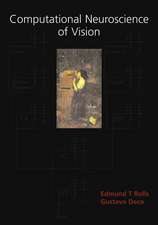Cortical Deficits in Schizophrenia: From Genes to Function
Editat de Patricio O'Donnellen Limba Engleză Hardback – 12 noi 2007
| Toate formatele și edițiile | Preț | Express |
|---|---|---|
| Paperback (1) | 942.63 lei 43-57 zile | |
| Springer Us – 11 sep 2014 | 942.63 lei 43-57 zile | |
| Hardback (1) | 800.32 lei 38-44 zile | |
| Springer Us – 12 noi 2007 | 800.32 lei 38-44 zile |
Preț: 800.32 lei
Preț vechi: 1053.06 lei
-24% Nou
Puncte Express: 1200
Preț estimativ în valută:
153.14€ • 160.32$ • 126.71£
153.14€ • 160.32$ • 126.71£
Carte tipărită la comandă
Livrare economică 02-08 aprilie
Preluare comenzi: 021 569.72.76
Specificații
ISBN-13: 9780387743509
ISBN-10: 0387743502
Pagini: 239
Ilustrații: XIII, 239 p.
Dimensiuni: 155 x 235 x 19 mm
Greutate: 0.69 kg
Ediția:2008
Editura: Springer Us
Colecția Springer
Locul publicării:New York, NY, United States
ISBN-10: 0387743502
Pagini: 239
Ilustrații: XIII, 239 p.
Dimensiuni: 155 x 235 x 19 mm
Greutate: 0.69 kg
Ediția:2008
Editura: Springer Us
Colecția Springer
Locul publicării:New York, NY, United States
Public țintă
ResearchDescriere
The genetics of schizophrenia have taken the driver seat in the research - lated to this disorder in recent years. For a long time, it had been known that sharing genes with someone affected with schizophrenia conferred a 50% chance of acquiring the disease. Although this is fifty times the incidence in the normal population, it was evident that genes could not explain all factors involved. At best, one could think of a combination of gene traits conferring predisposition for the disease. Now, it is evident that although there are no genes that individually confer a strong liability, several candidate gene alleles do confer some risk, and perhaps a combination of genes could cause the emergence of symptoms in this multi-faceted psychiatric condition. As the research on predisposing genes soars, it is becoming clear that we need to be able to identify cellular processes the genes control and to provide pat- physiological scenarios that could link those cellular phenomena with sy- toms. In this book, we have chosen to elaborate on that link. The contributions to this book have been requested to reflect the current state of the connection between schizophrenia genetics and pathophysiology. The book opens with a chapter by Paul Harrison highlighting the several convergence points among the diverse schizophrenia-related genes.
Cuprins
Schizophrenia Genes: Searching for Common Features, Functions, and Mechanisms.- Towards a Molecular Classification of Illness: Effects of Schizophrenia Susceptibility Loci on Clinical Symptoms and Cognitive Function.- Homer: A Genetic Factor in Schizophrenia?.- Neuregulin-erbB Signaling and the Pathogenesis of Schizophrenia.- Nicotinic Cholinergic Cortical Dysfunction in Schizophrenia.- A Role for Glutamate Receptors, Transporters, and Interacting Proteins in Cortical Dysfunction in Schizophrenia.- Cortical Circuit Dysfunction in the NMDA Receptor Hypofunction Model for the Psychosis of Schizophrenia.- Alterations in Hippocampal Function in Schizophrenia: its Genetic Associations and Systems Implications.- Identifying Novel Target Genes in Psychotic Disorder Network Association Analyses.- Alterations in Cortical GABA Neurotransmission in Schizophrenia: Causes and Consequences.- Increased Cortical Excitability as a Critical Element in Schizophrenia Pathophysiology.
Recenzii
From the reviews:
"Cortical Deficits in Schizophrenia: From Genes to Function is an important contribution to the literature on schizophrenic syndrome analysis. It also can serve as an excellent model of productive interdisciplinary collaboration. Clinical as well as basic scientific specialists from a very wide variety of disciplines who share a common interest in schizophrenic syndrome analysis will find much new information in this work that is insightful, original, and exceptionally well integrated." (James A. Moses, PsycCRITIQUES, Vol. 34 (3), August, 2008)
"Cortical Deficits in Schizophrenia: From Genes to Function is an important contribution to the literature on schizophrenic syndrome analysis. It also can serve as an excellent model of productive interdisciplinary collaboration. Clinical as well as basic scientific specialists from a very wide variety of disciplines who share a common interest in schizophrenic syndrome analysis will find much new information in this work that is insightful, original, and exceptionally well integrated." (James A. Moses, PsycCRITIQUES, Vol. 34 (3), August, 2008)
Textul de pe ultima copertă
The genetics of schizophrenia have taken the driver seat in the research related to this disorder in recent years. For a long time, it had been known that sharing genes with someone affected with schizophrenia conferred a 50% chance of acquiring the disease. Although this is fifty times the incidence in the normal population, it was evident that genes could not explain all factors involved. At best, one could think of a combination of gene traits conferring predisposition for the disease. Now, it is evident that although there are no genes that individually confer a strong liability, several candidate gene alleles do confer some risk, and perhaps a combination of genes could cause the emergence of symptoms in this multi-faceted psychiatric condition. As the research on predisposing genes soars, it is becoming clear that we need to be able to identify cellular processes the genes control and to provide patho-physiological scenarios that could link those cellular phenomena with symptoms. Cortical Deficits in Schizophrenia: From Genes to Function elaborates on that link.
The contributions to this book reflect the current state of the connection between schizophrenia genetics and pathophysiology. The book opens with a chapter by Paul Harrison highlighting the several convergence points among the diverse schizophrenia-related genes. This is followed by chapters reviewing several different specific genes, including Neuregulin, DISC-1, dysbindin, and Homer, among others, and by several chapters presenting information on physiological cortical processes that could be affected by those genes. These include glutamatergic, GABAergic and cholinergic neurotransmission.
Current hot topics in schizophrenia research are also highlighted in the book. A concept that is gaining strength in the field, for example, is the role of inhibitory neurotransmission in schizophrenia pathophysiology, with converging (and convincing) data from post-mortem and imaging studies. The possibility of deficits in cortical inhibition (causing the emergence of "noisy" cortical activity) is discussed throughout the book in relationship with possible alterations in GABA and/or glutamate activity in several cortical areas including the prefrontal cortex and the temporal lobe. Thus, the chapters in this book summarize the current state of affairs in schizophrenia pathophysiology, with a consideration of genetic elements that may contribute to it. Cortical Deficits in Schizophrenia: From Genes to Function will prove a useful tool for those interested in a better understanding of schizophrenia. Even if more predisposing genes (not included in this book) become identified, the work laid out here will prove critical for assigning a functional (or dysfunctional) role to those genes. Although this is a fast-evolving field, the information and concepts covered in this book will likely be useful for years to come.
The contributions to this book reflect the current state of the connection between schizophrenia genetics and pathophysiology. The book opens with a chapter by Paul Harrison highlighting the several convergence points among the diverse schizophrenia-related genes. This is followed by chapters reviewing several different specific genes, including Neuregulin, DISC-1, dysbindin, and Homer, among others, and by several chapters presenting information on physiological cortical processes that could be affected by those genes. These include glutamatergic, GABAergic and cholinergic neurotransmission.
Current hot topics in schizophrenia research are also highlighted in the book. A concept that is gaining strength in the field, for example, is the role of inhibitory neurotransmission in schizophrenia pathophysiology, with converging (and convincing) data from post-mortem and imaging studies. The possibility of deficits in cortical inhibition (causing the emergence of "noisy" cortical activity) is discussed throughout the book in relationship with possible alterations in GABA and/or glutamate activity in several cortical areas including the prefrontal cortex and the temporal lobe. Thus, the chapters in this book summarize the current state of affairs in schizophrenia pathophysiology, with a consideration of genetic elements that may contribute to it. Cortical Deficits in Schizophrenia: From Genes to Function will prove a useful tool for those interested in a better understanding of schizophrenia. Even if more predisposing genes (not included in this book) become identified, the work laid out here will prove critical for assigning a functional (or dysfunctional) role to those genes. Although this is a fast-evolving field, the information and concepts covered in this book will likely be useful for years to come.
Caracteristici
Presents the latest research on how genetic predisposition can produce schizophrenia’s pathophysiological outcomes















